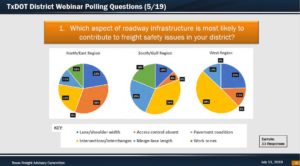Once again, a state agency tasked with serving the vastness of the Lone Star State has turned its attention to the Permian Basin. The reason: The Permian Basin Sphere of Influence.
 Those who live and work in the thick of it shared their perspective at the first meeting of the Permian Basin Regional Freight and Energy Sector Transportation Plan Steering Committee (the Steering Committee) on Sept. 19 at Midland College.
Those who live and work in the thick of it shared their perspective at the first meeting of the Permian Basin Regional Freight and Energy Sector Transportation Plan Steering Committee (the Steering Committee) on Sept. 19 at Midland College.
“The turnout from the Steering Committee was very strong, and so was the attendance from members of the public,” shared Stephen Robertson, executive vice president of the Permian Basin Petroleum Association (PBPA). “The Texas Department of Transportation [TxDOT] continues to do a great job of listening and taking in information from a variety of perspectives to make sure no stone is left unturned in the development of this plan.”
During the configuration of TxDOT’s 2018 Texas Freight Mobility Plan, numerous transportation issues related to the energy sector were documented, leading to the recommendation of a Permian Basin Regional Freight and Energy Sector Transportation Plan covering 22 Texas counties (Andrews, Borden, Crane, Crockett, Culberson, Dawson, Ector, Gaines, Glasscock, Howard, Irion, Loving, Martin, Midland, Pecos, Reagan, Reeves, Scurry, Upton, Ward, Winkler, Yoakum) and two New Mexico counties (Lea and Eddy).
The Steering Committee includes TxDOT, MOTRAN, The Permian Basin Metropolitan Planning Organization, and the Permian Basin Regional Planning Commission, along with representatives from the energy sector, including the PBPA, and other affected entities including water haulers, sand mine companies, utility districts, and school districts.
The Steering Committee is chaired by Ector County Judge Debi Hays. As a locally elected official who lives in the heart of the Permian Basin, Hays has firsthand knowledge of both the wealth and the worries that come with being the epicenter of energy production.
As the wealth continues (oil was over $60 per barrel as of press time), so do the worries.
“I am concerned,” Hays said after accepting the appointment as chair. “I need others to be just as concerned as I am. There is a human element to all of this, and we have an obligation to make sure those people in the industry and those outside the industry in the Permian Basin are safe.”
The Texas Freight Advisory Committee took note of those same statistics that worry Hays. As part of a report on creating a specialized Permian Basin plan, the Freight Advisory Committee asked and answered why the Permian Basin deserves special attention. Both the Permian Basin sphere of influence and the alarming safety concerns were among the answers:
1. Freight activity in the Permian Basin region has significant local, state, and national implications.
2. The region produces an average of 4 million barrels of oil a day (May 2019).
3. Growth and increasing energy sector freight volumes are outpacing investment.
4. Two thousand or more truck trips per new well are generated in the region.
5. Between 2010 to 2018, there was a 47 percent increase in the number of roadway crashes and a 64 percent increase in roadway fatalities.
6. The region generated over $4.9 billion in state revenue in 2017, accounting for nearly 10 percent of all state-generated general revenue.
This report also noted ongoing related challenges:
• Oil and gas movements are increasing significantly, and infrastructure is not keeping pace.
• Connectivity to freight generators needs to be improved.
• Many existing roads are not designed to carry the size and volume of trucks.
• Newer areas of freight-intensive development lack connectivity leading to circuitous routes.
• Lack of north/south connectivity.
• Access to I-20 is impeded by lack of connections and/or design of connectors.
Wheels in Motion
At the first meeting, with 33 in attendance, the Steering Committee voted and approved its goals and objectives and provided extensive feedback on the Regional Freight and Energy Sector Network, reported Adam Hammons, TxDOT media relations representative.
“While the count of freight traffic is a solid measurement for the increased traffic and use of state roads throughout the Permian Basin, an understanding of that freight, why it exists, where it originates, and where it terminates is just as important and helps to really tell the full story of the transportation needs in our corner of Texas,” said Robertson, who participated in the meeting. “So much of that information needed to be collected and analyzed by TxDOT so that we would have an up-to-date base of knowledge to begin future planning.”
The development of the Permian Basin Regional Freight and Energy Sector Transportation Plan will be based on the following newly adopted goals centering on Safety, Economic Competitiveness, Mobility and Reliability, Connectivity, Sustainable Funding, Stewardship, Customer Service, and Asset Preservation, Hammons stated. Specifically, the plan will seek to:
Improve the safety of the Permian Basin region’s multimodal freight system.
Enhance the economic competitiveness, productivity, and development in the Permian Basin region and beyond by ensuring the region’s freight transportation network is adequate to support the energy sector and other freight-intensive industries.
Enhance mobility and improve system efficiency and performance on the Permian Basin region’s transportation system by expanding capacity and addressing freight bottlenecks.
Improve urban and rural system connectivity between all freight modes within the Permian Basin region and all industry sectors to regional, statewide, national, and international markets.
Identify and sustain funding sources for the energy sector’s and Permian Basin region’s freight transportation system.
Manage environmental and agency resources responsibly and foster accountability and transparency in decision-making.
Encourage local ownership of and coordination in the development of the Regional Freight Plan by engaging public and private stakeholders in transparent dialogue to determine consistent and comprehensive regional transportation planning strategies and recommendations.
Maintain and preserve the Permian Basin’s transportation infrastructure that supports multimodal movement of energy sector freight, goods and people.
The Steering Committee also formally adopted objectives that include data gathering, development of short- and long-term actionable strategies, and consideration of the final plan by the Texas Transportation Commission possibly in June 2020.
Optimism and Next Steps
Over-taxed roads and safety concerns have been reiterated throughout the last several decades, Hays noted. Recent funding from the Texas Legislature dedicated to energy sector roads along with TxDOT’s focus on a specific energy sector plan have served as sources of optimism.
 “TxDOT continues to define the Freight and Energy Sector Network of roads in the Permian Basin using input from organizations like the PBPA as well as local elected officials and stakeholders,” Robertson noted.
“TxDOT continues to define the Freight and Energy Sector Network of roads in the Permian Basin using input from organizations like the PBPA as well as local elected officials and stakeholders,” Robertson noted.
“Through PBPA’s involvement with TxDOT’s planning and steering committees, the feedback we’ve received, and the way we’ve seen the efforts evolve definitely shows us that TxDOT is doing everything it can to understand how the Permian Basin may be unique compared to other areas of the state when it comes to infrastructure.”
The final agenda item at the Steering Committee’s inaugural meeting centered on next steps.
“We are finalizing identification of the Regional Freight and Energy Sector Network and working on the Regional Freight Profile and Economic Impact,” Hammons listed. “We are also working on the Regional Freight Needs Assessment and Regional Freight Forecasts in 10-year increments out to 2045. We’ll soon have fact sheets on Economic Significance of Regional Freight Movement.”
All of these items will be completed within the next 90 days, or around mid-March, Hammons continued. The next round of stakeholder outreach efforts and the second meeting of the Steering Committee will be in spring 2020.
The entire State of Texas will benefit from this process, Hays said, as will the rest of the nation.
____________________________________________________________________________________________________
Julie Anderson, based in Lubbock, is editor of County Progress Magazine, and is well known to many readers of PBOG as the prior editor of this magazine.









